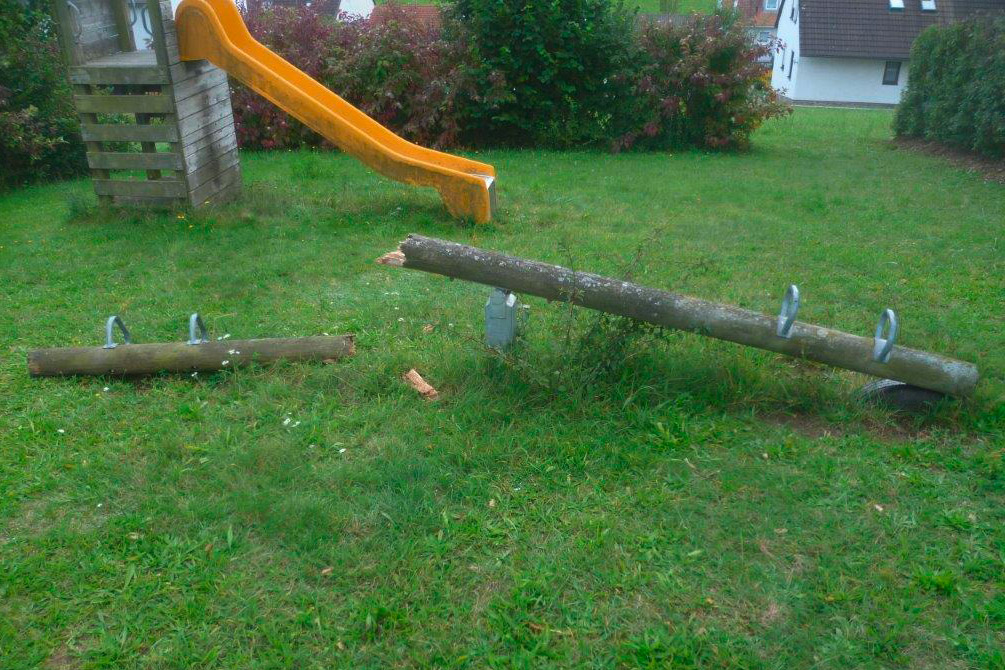The ravages of time also gnaw away at wooden playgrounds – but how long is the service life of such wooden structures? And what happens to the wood of adjusted facilities? The choice of wood is crucial for a long service life of playground equipment and facilities because not all wood is the same – some species are much more robust than others. The future location of the play structure, weather conditions and intensity of use, therefore, play a major role in the choice. Those who choose wood species with high inherent resistance and also have regular playground inspections carried out make a significant contribution to the long life of the facility. In this way, playground operators also do themselves a big favour in terms of disposal.
Table of contents
- What type of wood makes a wooden playground durable?
- Structural protective measures for the wooden playground
- Controls extend the life of wooden playgrounds
- When a wooden playground ages and needs to be disposed of
- How to dispose of the scrap wood?
- Conclusion: Already have the disposal in mind when planning the wooden playground
What type of wood makes a wooden playground durable?
There are two types of wood used in construction: Species with a high, natural inherent resistance are ideal for outdoor use. Species that do not have this sufficiently require constructive or chemical protection measures. The chemical option is the most favourable, but also the most problematic. According to the durability classes according to DIN EN 350-2 – the standard refers to the resistance of wood to fungal attack – Robinia is particularly suitable for outdoor use. European oak is also classified as “durable”. Spruce, beech or birch, on the other hand, have only low natural durability and should be supported by constructive (recommended) or chemical wood preservatives. Wood species for outdoor use are normally not very susceptible to harmful insects – but caution is required in the case of fungal attack. Often the wood structure in a beam is already destroyed, although it still appears stable from the outside.
Constructive protective measures for the wooden playground
To extend the life of wooden playgrounds, it is best to resort to constructive protective measures. They are also ideal for supporting low inherent resistance. First and foremost, they are aimed at eliminating sources of moisture that could soak into the wood.
Basically, the measures include protection against:
- precipitation as well as rapid drainage of rainwater (waterlogging must be avoided at all costs).
- splashing water
- rising damp (for example, by using post shoes to avoid direct contact with the ground)
- capillary water
- condensation water
To do this, you should pay attention to the durability class of the wood species used. Screw connections should be countersunk into the wood or pre-drilled. This is because cracks or break-outs in the wood are an open invitation to fungi. Structural measures require far-sighted planning in order to withstand any changes in the substrate or Environment.
Inspections extend the life of wooden playgrounds
To counteract possible wood damage at an early stage, regular inspection and maintenance is a must. Only in this way will your wooden playground achieve a long service life. The three-stage control system of DIN EN 1176 is recommended for every playground operator:
- 1 x per week: Inspection of the playground equipment for damage or conspicuousness by operators or commissioned experts. In socially deprived areas, a daily visual inspection of the equipment is recommended.
- 1 to 3 x per month: Thorough check for wear and tear of the equipment – here, you must also follow the manufacturer’s instructions for maintenance and care.
- 1 x per year: Intensive check of operational safety by an expert who inspects the wooden playground, especially with regard to stability, stability and repairs already carried out.
When a wooden playground ages and has to be disposed of
Whether it’s due to old age, external force, or abandonment of the space for other reasons, at some point, even the best piece of wood has its day. Ideally, the disposal, recyclability, compostability and reuse of the wood has already been considered when developing playgrounds and equipment. It is, therefore, worthwhile to take a look at the seriousness of the manufacturer already at the time of purchase. Waste wood can be divided into several categories according to the Bavarian State Office for the Environment:
- Natural wood, which has not been treated with substances foreign to wood
- Processed wood that has come into contact with glue, paint, varnish or similar substances
- Wood that has been coated with, e.g. PVC
- Wood that has been treated with wood preservatives
- Wood containing PCBs, such as insulation and soundproofing boards
How to dispose of the scrap wood?
You can dispose of normal household quantities of scrap wood at your local recycling centre or with bulky waste. Wood that is in good condition and in its natural state can often be reused for other purposes – saving you waste and protecting the Environment. However, as soon as larger quantities are involved – which is probably the case with a wooden playground – the wood is disposed of in waste wood processing plants. For this, you must declare the quantity, type, origin and treatment condition of the wood in advance. It is particularly important to declare “hazardous” waste wood – this concerns wood containing PCBs and wood treated with wood preservatives. In some cases, this even requires an analytical examination. This is why it is so important to use good, robust and durable wood when choosing or building a playground – this will save you a lot of work if the worst comes to the worst. For quantities over 100 kilograms, a delivery bill for waste wood or various practical documents such as delivery and weighing bills are required (in accordance with § 11 Para. 4 of the Waste Wood Ordinance).
Conclusion: Already have a disposal in mind when planning the wooden playground
We think that the Environment concerns us all! That is why eibe considers the factors of durability and disposal of wood already in the product development. Wood, as a CO2-neutral and resource-saving raw material, is not without reason our main material number one! By the way, the problem of the lifespan of wooden playgrounds can be circumvented in a very simple way – at least when it comes to individual elements. Instead of building cottages or fences from “dead” wood, let it grow instead. Elements made of living plant material also look really good. Willow plants, for example, are wonderful for building huts, tents or play walls.
Read more: Good wood is important for safe play equipment. It is even better if it is also FSC® certified and comes from sustainable forestry and forest management. Read all the info about this certification here!

